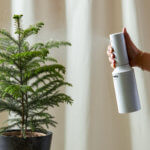Some yellowing is natural.
Is your Homalomena producing new growth? If there is new growth on your plant and the yellowing leaves are older, particularly at the bottom of the plant, this yellowing is natural. Your plant sheds its old leaves and sends energy to new growth. It is normal to see a leaf yellowing every few weeks. If it is happening more often than that, it can indicate that something is wrong.
Moisture
The most common cause of yellowing leaves among Homalomena plants is improper soil moisture–in particular, overwatering. Your Homalomena likes their soil to dry out almost completely before watering again, but once the soil dries be sure to water it thoroughly. If you let the soil sit dry for an extended period of time, it can also cause yellowing leaves.
When you water your Homalomena, make sure you provide enough water so that liquid flows from the drainage hole at the bottom of the pot and into the saucer. It’s extremely important to discard any excess water in the saucer and not to let your plant sit in any standing water. Your plant doesn’t like “wet feet,” which will cause the roots to rot and lead to the eventual death of the plant. Yellow and browning leaves are the first sign that root rot may be occurring.
Temperature
Your Homalomena is very sensitive to cold temperatures below 50 degrees. They prefer warm temperatures above 70 degrees. If they are exposed to cold drafts or sudden temperature drops, they can respond by leaves yellowing. Don’t worry, the plant can easily bounce back as long as you move it back to a warm spot.
Humidity levels
Low humidity and dry soil cause leaves to droop and brown on their edges, later followed by entire yellowing, browning, and shriveling. Your Homalomena will appreciate a boost in humidity from regular misting, a humidifier, or pebble tray.
Pests
A weakened or stressed Homalomena is more susceptible to insect infestations. Sap-sucking bugs like spider mites can drain your plant of moisture. This problem quickly manifests itself by yellowing leaflets and fronds. Scale, mealybugs, and spider mites occur frequently in indoor conditions. If not killed early on, these small pests proliferate and move all along frond parts into nooks and crannies. The piercing mouths of the insects exhaust your plant and accelerate yellowing, especially if your Homalomena is already unhealthy from poor lighting, a nutrient deficiency or improper soil moisture. Learn how to treat common houseplant pests here.










